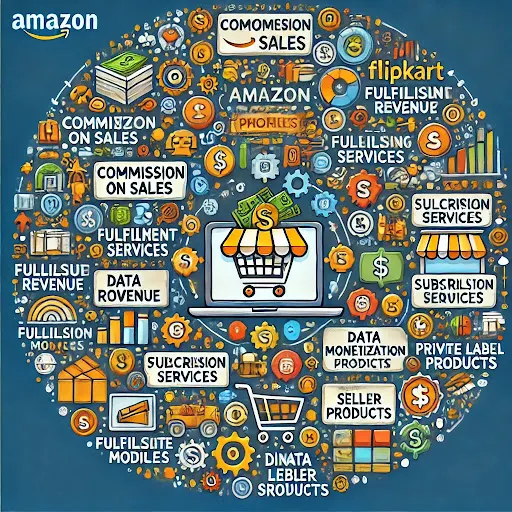Online shopping platforms such as Amazon, Flipkart, and Meesho have revolutionized the e-commerce industry, earning revenue through various strategies. Here’s a detailed look at how they generate income:
1. Commission on Sales
- Marketplace Model: These platforms act as intermediaries between sellers and buyers. They charge sellers a commission for every sale made through the platform. This commission varies based on the product category, brand, and seller’s agreement with the platform.
- Subscription Fees: Amazon has services like Amazon Prime, which offers benefits like free delivery, exclusive deals, and access to Prime Video. Prime memberships contribute significantly to Amazon’s revenue. Similarly, sellers can subscribe to premium services to enhance visibility and gain benefits like better listings and access to customer data.
2. Advertising
- Sponsored Listings: Sellers can pay for their products to be listed higher in search results, increasing visibility. Platforms like Amazon and Flipkart offer sponsored ads that appear prominently on product pages.
- Display Ads: These platforms allow third-party brands to advertise on their websites and apps, earning revenue from the ads. For instance, companies may pay to promote their products via banner ads or video ads on the homepage or category pages.
3. Fulfillment Services
- Fulfillment by Amazon (FBA): Amazon charges sellers for storing their inventory in Amazon’s warehouses and for packing, shipping, and customer service through its fulfillment network. This generates additional revenue from sellers who prefer Amazon to handle the logistics.
- Warehousing and Logistics: Platforms like Flipkart offer end-to-end logistics solutions for sellers, which includes warehousing, packaging, and delivery. They charge fees for these services.
4. Subscription Models
- Amazon Prime: By offering services like faster delivery, exclusive deals, and streaming services, Amazon encourages users to subscribe to Prime, which provides a steady stream of subscription revenue.
- Flipkart Plus: Flipkart also has a loyalty program that offers benefits like faster delivery and early access to sales for a subscription fee.
5. Affiliate Marketing
- Affiliate Programs: Amazon, Flipkart, and Meesho offer affiliate programs that allow individuals or companies to promote products on their platforms in exchange for a commission. Affiliates drive traffic to these platforms and earn a percentage of sales made through their referral links.
6. Data Monetization
- Customer Data: These e-commerce platforms collect vast amounts of data on customer behavior, preferences, and purchasing patterns. They may sell this data to third parties or use it internally to improve targeted advertising and personalized recommendations.
7. Financial Services
- Amazon Pay, Flipkart Pay Later: Platforms like Amazon and Flipkart have ventured into the financial services sector by offering digital wallets and buy-now-pay-later (BNPL) services. They earn revenue through transaction fees, interest charges on late payments, and other financial services offered to customers.
8. Private Label Products
- In-House Brands: Amazon and Flipkart have launched their own private label products (e.g., Amazon Basics, Flipkart SmartBuy). These products often offer higher margins because they eliminate middlemen, allowing the platforms to control the supply chain and pricing.
9. Third-Party Seller Services
- Logistics and Payment Gateways: Meesho, in particular, has a significant focus on enabling small businesses and individual sellers. The platform earns money by providing third-party services, such as logistics, payment processing, and customer support, in exchange for fees.
10. Global Marketplaces
- Cross-Border Trade: Amazon and Flipkart have international seller programs, allowing sellers to reach customers worldwide. This global marketplace earns them revenue through currency conversion fees, international shipping, and global advertising.
Conclusion
E-commerce giants like Amazon, Flipkart, and Meesho utilize a multi-faceted approach to generating revenue. Through a combination of commissions, advertising, fulfillment services, subscriptions, financial services, and data monetization, they have built robust and scalable business models that dominate the online shopping ecosystem.







.jpg)
.jpg)

Please avoid spamming the comments section. All comments are reviewed by the admin before being published. Your cooperation is appreciated!